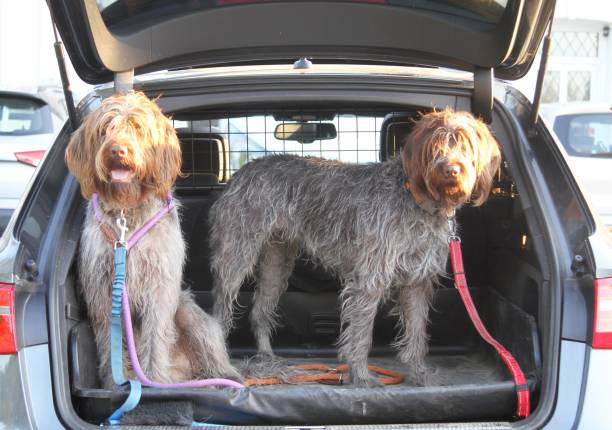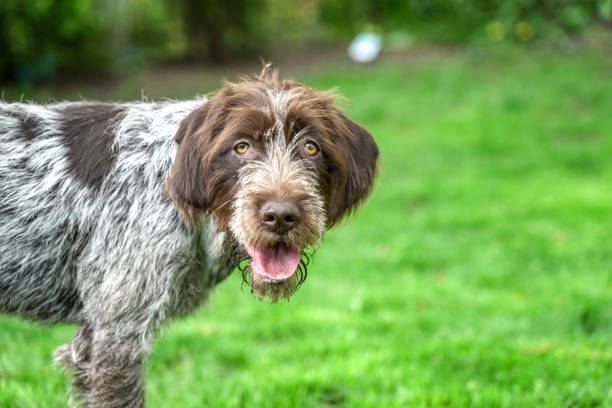Wirehaired Pointing Griffon

Breed History:
The Wirehaired Pointing Griffon is a versatile gun dog developed in the late 19th century by Dutch breeder Eduard Karel Korthals. Though Dutch by origin, the breed was perfected in France, where Korthals refined it through careful selection and crossbreeding with various pointing and hunting breeds, including German Pointers, Setters, and Spaniels.
Korthals aimed to create the ideal rough-coated, all-terrain hunting dog, and by the 1880s, his efforts led to a breed with strong pointing, retrieving, and tracking instincts, as well as a close working style. The Wirehaired Pointing Griffon is now widely recognised in Europe and North America as an outstanding, versatile hunting companion and family dog.
The breed is sometimes referred to as the "Supreme Gundog" for its cooperative temperament, sharp nose, and adaptability in water and land-based hunting.
Considering adopting a pointer breed? Check out our page "How to look after a Pointer" detailing what to consider before adopting and our recommended products.
|
Gender |
Height |
Weight |
|
Male |
55-60 cm |
23-27 kg |
|
Female |
50-55 cm |
18-23 kg |
Size – Medium
Life Expectancy: 12–14 years

Breed Appearance:
The Wirehaired Pointing Griffon has a distinctive rustic appearance, characterised by a harsh, wiry outer coat and a soft, dense undercoat. The coat is often steel grey with brown markings, though liver and white or chestnut combinations also exist. Its most notable features are its shaggy eyebrows, moustache, and beard, which give it a charming, expressive look.
The body is slightly longer than tall, with a strong, athletic build, a broad chest, and a level topline. The tail is typically docked in countries where it is allowed. The breed’s amber eyes have an alert, intelligent expression, and the ears are medium-length and slightly rounded.
Breed Type – Versatile Gun Dog / Companion:
Bred as a multifunctional hunting dog, the Wirehaired Pointing Griffon excels in pointing, retrieving, tracking, and even waterfowl hunting. It works closely with its handler and is prized for its trainability and natural hunting instinct.
Beyond its field prowess, it is also a devoted family companion, known for being affectionate, gentle, and loyal. The Griffon is typically friendly with children and other dogs, making it a great choice for active families who enjoy the outdoors. It does not do well when isolated or bored, as it thrives on interaction and purpose.

Training:
This breed is highly intelligent, eager to please, and generally easy to train, especially for handlers with experience in hunting or working breeds. The Griffon responds well to positive reinforcement, gentle correction, and clear, consistent commands.
It is a sensitive dog that may shut down under harsh treatment, so a supportive training approach is essential. It excels in obedience, field trials, agility, and search-and-rescue roles. Early socialisation helps the Griffon become confident in various environments, especially if it's to be a family pet as well as a working dog.
Health & Care:
The Wirehaired Pointing Griffon is a generally healthy breed with relatively few inherited health issues. Responsible breeding has helped maintain its vigour.
Potential health concerns may include:
-
Hip dysplasia
-
Elbow dysplasia
-
Eye conditions such as progressive retinal atrophy (PRA)
-
Ear infections (due to floppy ears)
Routine veterinary care, proper grooming, and a high-quality diet help ensure a long and healthy life. Because of its active nature, the breed benefits from joint supplements and regular physical checkups, especially as it ages.

Living Conditions:
Though adaptable, the Wirehaired Pointing Griffon is best suited to homes with space, such as rural properties or suburban homes with large yards. It can adapt to apartment life if given enough daily exercise and mental stimulation, but thrives in environments where it can run, explore, and stay active.
The breed prefers to live indoors with its family, not in isolation. It is not a kennel dog and may become anxious or destructive if left alone for long periods. It does well in temperate climates but should be monitored in extreme heat due to its dense undercoat.
Exercise:
The Griffon is a high-energy, athletic breed that requires at least 60–90 minutes of daily exercise. It enjoys long walks, hikes, swimming, and interactive games. It particularly thrives when allowed to practice field work like tracking, pointing, or retrieving.
Mental stimulation is just as important. Puzzle toys, obedience drills, and scent work can help keep its active mind engaged. Without adequate activity, the Griffon may develop restlessness, barking, or digging behaviours.
Grooming:
The wire coat of the Wirehaired Pointing Griffon is relatively low-maintenance but requires regular brushing (at least once a week) to prevent matting and to remove dirt and debris.
Occasional hand-stripping (plucking of dead hairs) helps maintain the texture of the coat and reduces shedding. Ears should be cleaned regularly to prevent infection, and nails trimmed monthly. Bathing is needed only occasionally, as the breed tends to stay fairly clean.
Inspect for burrs, ticks, or plant matter after time outdoors, especially in wooded or brushy areas.

Advantages:
-
Excellent hunting and retrieving abilities
-
Highly trainable and eager to please
-
Friendly, loyal, and good with families
-
Distinctive, low-shedding coat
-
Adaptable to various terrains and climates
-
Intelligent and cooperative in training
Disadvantages:
-
Needs significant daily exercise and engagement
-
Not suited for sedentary or apartment-only lifestyles
-
Sensitive to harsh training methods
-
May become bored or destructive if under-stimulated
-
Requires hand-stripping to maintain coat texture
-
Can be prone to ear infections if not regularly cleaned

